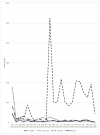From English to Chinese, Japanese, and Russian: extending research visibility with language translations of a conference slide presentation
- PMID: 28096746
- PMCID: PMC5234450
- DOI: 10.5195/jmla.2017.106
From English to Chinese, Japanese, and Russian: extending research visibility with language translations of a conference slide presentation
Abstract
Objective: The research demonstrates that a conference slide presentation translated into non-English languages reaches significantly larger and different audiences than an English presentation alone.
Methods: The slides of a presentation from the Medical Library Association annual meeting were translated from English to Chinese, Japanese, and Russian and posted along with the English version to SlideShare, an open slide-hosting website. View counts, traffic sources, and geographic origins of the traffic for each language version were tracked over a twenty-two-month period.
Results: Total view counts for all 4 language versions amounted to 3,357 views, with the Chinese version accounting for 71% of the total views. The trends in view counts over time for the Japanese, Russian, and English versions were similar, with high interest at the beginning and a rapid drop and low level of viewing activity thereafter. The pattern of view counts for the Chinese version departed considerably from the other language versions, with very low activity at the beginning but a sharp rise 10 months later. This increase in activity was related to access to the presentations via a Taiwanese website that embedded the SlideShare website code.
Conclusions: Language translation can be a difficult and time-consuming task. However, translation of a conference slide presentation with limited text is an achievable activity and engages an international audience for information that is often not noticed or lost. Although English is by far the primary language of science and other disciplines, it is not necessarily the first or preferred language of global researchers. By offering appropriate language versions, the authors of presentations can expand the reach of their work.
Figures
References
-
- Suber P. Open access [Internet] Cambridge, MA: MIT Press; 2012. [cited 1 Aug 2016]. < http://mitpress.mit.edu/books/open-access>.
-
- Lewis MP, Simons GF, Fennig CD. Ethnologue: languages of the world [Internet] 19th ed. Dallas, TX: SIL International; 2016. [cited 1 Aug 2016]. < http://www.ethnologue.com>.
-
- Ballabeni A. Levelling the lingo playing field. EMBO reports [Internet] 2015;16:769–70 . [cited 1 Aug 2016]. < http://embor.embopress.org/content/16/7/769.export>. - PMC - PubMed
-
- La Madeleine BL. Lost in translation. Nature. 2007 Jan 24;445:454–5. DOI: http://dx.doi.org/10.1038/nj7126-454a. - DOI - PubMed
-
- Tardy C. The role of English in scientific communication: lingua franca or tyrannosaurus rex? J English Academic Purposes. 2004 Jul;3(3):247–69. DOI: http://dx.doi.org/10.1016/j.jeap.2003.10.001. - DOI
MeSH terms
LinkOut - more resources
Full Text Sources
Other Literature Sources

